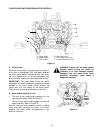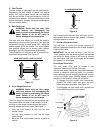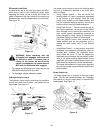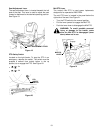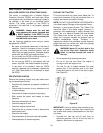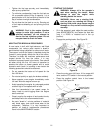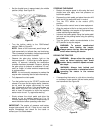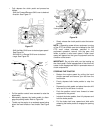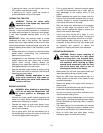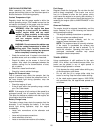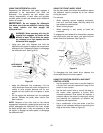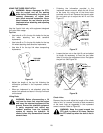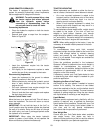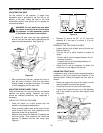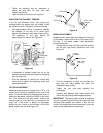
24
• If leaving the tractor, turn the ignition key to the
OFF position and remove the key.
• If parking on an incline, chock the wheels to
prevent accidental rolling of the tractor.
TURNING THE TRACTOR
WARNING: Turning the tractor while
traveling at a fast speed may cause the
tractor to overturn.
NOTE: The tractor is equipped with hydraulic power
steering. If front mounted equipment is installed on
the tractor and the engine is running at a slow speed,
it may take increased steering effort to turn the
tractor.
IMPORTANT: When the steering wheel is turned
completely and held in this position, the hydraulic
system may emit a high pitched sound from the relief
valve being actuated. Avoid prolonged turns with the
tractor’s steering wheel held in the completely turned
position.
• Always slow down the tractor by reducing throttle
speed and/or downshifting the transmission
before turning the tractor.
• Engagement of the differential lock will prevent
proper steering and could cause loss of tractor
control when turning. Always release the
differential lock pedal and make the certain it is
disengaged before turning the tractor.
• Use the individual wheel brakes to assist turning
ONLY when the tractor is working in the field and
operating at slower speeds.
WARNING: Sudden application of one
brake while traveling at high speed or
while making fast turns could cause the
tractor to roll over.
DRIVING ON SLOPES
WARNING: When climbing or descending
a hill, do not shift the transmission into
the neutral position or disengage the
clutch.
• Interlock the brake pedals before operating the
tractor on a slope. Never use the individual wheel
brakes when operating on a slope.
• Operate the tractor up and down slopes, never
across slopes. Do not drive so that the tractor
may tip over sideways.
• Prior to going uphill, shift the transmission into a
low enough gear to allow the tractor to climb the
hill without lugging down the engine.
• Prior to going downhill, reduce the engine speed
and shift the transmission into a lower gear to
take advantage of the braking action of the
engine.
• Before operating the tractor on a slope, walk the
slope to look for possible hazards such as rocks,
mounds, stumps, or surface irregularities which
could cause the tractor to be upset.
• Back the tractor with attachment up the steepest
portion of each slope you intend to work. If the
tractor cannot negotiate the slope in reverse, the
slope is too steep to be worked.
• Avoid turns when driving on a slope. If a turn
must be made, turn down the slope. Turning up a
slope greatly increases the chance of a roll over.
• Avoid stopping when driving up a slope. If it is
necessary to stop while driving up a slope, start
up smoothly and carefully to reduce the
possibility of flipping the tractor over backward.
DRIVING ON ROADWAYS
WARNING: Ensure proper weighting of
the tractor, and travel at a safe speed
when driving with a rear mounted imple-
ment in the raised position. Bouncing of
the implement while traveling at higher
speeds could momentarily raise the front
end of the tractor and result in loss of
steering and control of the tractor.
• Make certain the left and right brake pedals are
interlocked before driving on public roads.
• Attach an SMV (slow moving vehicle) sign in a
visible location on the back of the tractor or rear
mounted equipment.
• Reduce the speed of the tractor when turning on
sharp curves.
• Downshift the transmission and use the engine to
brake when descending steep slopes.
• Use the turn signal to alert other vehicles of your
intentions when making turns.
• If driving after dusk or before dawn, turn on all the
tractor lights - including the flashing hazard lights.
Dim the headlights to oncoming traffic if using the
high beams.
• Pay close attention for low shoulders on the side
of the road. Dropping the tractor’s wheels off the
road onto a low shoulder could upset the tractor.
• Obey all traffic laws and allow faster moving
vehicles to pass. Do not block the road.



